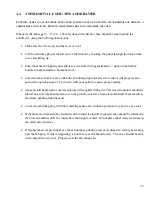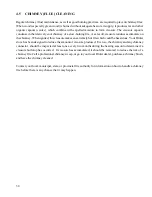
36
SECTION 4.0
MAINTENANCE
4.1
CLEANING AND PAINTING YOUR STOVE
Clean the stove frequently so that soot, ash, and creosote do not accumulate. Do not attempt to clean
the stove when the unit is hot. Special care must be taken with gold plated surfaces in order to
maintain the finish at its original brilliance. Do not use an abrasive cleaner which will scratch the
paint or plated finish. Use only a soft and clean damp cloth.
If the paint becomes scratched or damaged, it is possible to give your wood stove a brand new look,
by repainting it with a 650
o
C heat resistant paint. For this purpose, simply scrub the surface to be
repainted with fine sand paper, clean it properly, and apply thin coats (2) of paint successively. To
retrieve the original finish, use the paint supplied by the manufacturer.
4.2 GLASS
Inspect the glass regularly in order to detect any cracks. If you spot one, turn the stove off immediately.
Do not use the stove if the glass is broken.
If the glass on your stove breaks, replace only with a glass supplied by your Drolet dealer.
To replace the glass, remove the screws retaining the glass retainers inside the door. Remove the
mouldings and replace the damaged piece with a new one. Perform the procedure backwards after
replacing. When replacing the glass, you should change the glass gasket to make sure you keep it sealed.
Never wash the glass with a product that may scratch it. Use a specialized product, available in the stores
where wood stoves are sold. Only wash when the stove is cold.
Under normal operating conditions, the glass is designed to stay clean. Glass cleaning may be required
when burning damp wood. Furthermore, small creosote or soot accumulation may occur in the lower end
corners of the glass when burning the stove with the air control at the minimum setting.
This is normal
.
The glass will clean itself when burning a hot fire during one hour or more with the air control at its
maximum setting. Nevertheless, cleaning the glass on a regular basis is recommended to prevent thicker
creosote or soot accumulation that can be very hard to remove.
4.3 GASKETING
It is recommended that you change the door gasket (which makes your stove door air tight) once a year, in
order to insure good control over the combustion, maximum efficiency and security. To change the door
gasket, simply remove the damaged one. Carefully clean the gasket groove, apply a high temperature silicone
sold for this purpose, and install the new gasket.
Use only the genuine Drolet gasket.
You may light up your
stove again approximately 24 hours after having completed this operation.





































